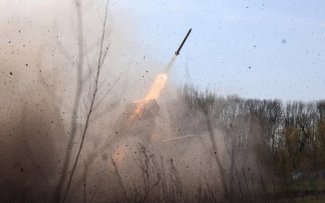Russian advances in Sumy Oblast. Day 1210 of the war

![]()
The Russians are continuing their assault in Sumy Oblast, concentrating on breaking through Ukrainian defences in Yunakivka and Andriivka. On 14 June, President Volodymyr Zelensky announced the recapture of the latter from occupying forces. Russia’s objective is to reach the Khotin–Pysarivka–Sadky village line, located on hills favourable to it that enable it to effectively shell and terrorise Sumy using artillery and drones, and to reach the wide strip of forest areas surrounding the city from the north. Russia’s offensive actions are prominently supported by the ‘Rubicon’ unit of drone operators responsible for destroying the logistics and drone reconnaissance of the defenders.
Russian forces have not ceased their intensive attempts to surround Kostiantynivka in Donetsk Oblast. Fighting continues in the vicinity of Chasiv Yar and key logistical routes leading to Kostiantynivka from Pokrovsk (Russia’s capture of Malynivka and Hrodivka), Donetsk (clashes over Yablunivka), Toretsk (capture of Dyliivka). Russian troops managed to gain advances east of Kurakhove towards the border of the Donetsk and Dnipropetrovsk oblasts. They are also thought to have taken control of Komar, Odradne, Bahatyr, Novopil and Bohdanivka. The Ukrainians, in turn, successfully counterattacked in Kotliarivka. According to reports from the Russian defence ministry, their troops have reached the border of Dnipropetrovsk Oblast, though Ukraine denies this. The villages of Dvorichna, Zapadne and Dovhenke in Kharkiv Oblast and Malynivka in Zaporizhzhia Oblast also came under Russian control.
![]()
On the night of 16–17 June, Russia launched another massive attack on Ukraine. According to Ukrainian sources, 440 strike drones or their imitators, six Kinzhal missiles, 16 Kh-101 and nine Kh-59/69 cruise missiles and one Kh-31P anti-radar missile were used. In Sumy, Ukraine is thought to have shot down 428 of the 472 missiles. Kyiv was the main target. Among the objects hit in the attack were a nine-storey residential building, the Kyiv Aviation Institute dormitory, post office branches, railway infrastructure facilities and industrial plants. The impact left at least 15 people dead and more than 100 injured. Attacks also occurred in Zaporizhzhia (hitting a residential building and a boarding school, among others), Odesa (residential buildings, educational facilities), as well as Chernihiv, Kherson and Konotop, among others.
On 11 June, Kharkiv was the target of a drone attack – two people were killed and 54 injured. On the same day, energy infrastructure facilities in Kherson Oblast were hit. On 15 June, meanwhile, Russia carried out a missile and drone strike on the Kremenchuk refinery in Poltava Oblast.
![]()
On 16 June, General Oleksandr Tarnavskyi, commander of the operational-tactical military grouping ‘Donetsk’, responsible for the defence of the eastern sections of the front, including the areas on the border of the Donetsk and Dnipropetrovsk oblasts, resigned. His place was taken by General Viktor Nikoliuk, previously chief of staff of this grouping. The official reason for the resignation of Tarnavskyi, who had held the post since last December, was said to be health problems. Nikoliuk famously efficiently commanded the defence of Chernihiv at the start of the full-scale invasion in 2022. He was also responsible for the training of soldiers in the Land Forces Command.
On 12 June, the Ministry of Defence of Ukraine announced the launch of a pilot programme for the creation of air defence groups based on local volunteer formations. Based on a resolution adopted the day before by the Council of Ministers, civilian members of these teams were allowed to use private aircraft, drones, small arms and electronic warfare means to detect, monitor and neutralise airborne threats, including primarily enemy strike and reconnaissance drones. The project is being implemented by the Ministry of Defence together with the Ministry of Digitalisation in cooperation with the General Staff of the Armed Forces. The groups will operate on a territorial basis and will be organisationally subordinate to the local commanders of the Territorial Defence Forces, while operationally they will be under the orders of the Air Force of the Armed Forces of Ukraine and will operate within the framework of air defence.
Also on 12 June, Kyiv mayor Vitali Klitschko announced the delivery of a new batch of aid to two military units. Soldiers of the 112th Territorial Defence Brigade received 2,400 drones – 2,300 FPV assault drones (including fibre optics) and 100 reconnaissance drones – as well as five ground control stations for the drones. In turn, the stock of the 92nd Separate Assault Brigade named after Ataman Ivan Sirko increased by five trucks. Klitschko recalled that this year alone, the first of these subdivisions has already received a total of 4,400 drones funded from the city budget. Prior to that, he announced the preparation of a project to increase support to the army by another 2 billion hryvnias (about $48 million). Two days earlier, former President Petro Poroshenko who, alongside Klitschko, is considered a political rival by President Zelensky’s entourage, donated another batch of equipment and drones to the Ukrainian Armed Forces. The support, worth a total of almost 40 million hryvnias (about $1 million), will go to 14 brigades fighting on the frontline. The aid included 1,000 FPV drones (including 100 with fibre optic transmission). Poroshenko also announced the delivery of 12 excavators (he funded the delivery of 106 in total) for the construction of fortifications and mobile container repair workshops.
On 11 June, General Mykhailo Drapatyi – the former commander of the Land Forces – summed up his six months in the post. As he stressed in a statement, he is leaving his post with a clear conscience, hoping that the reforms he started will be continued. Drapatyi took up his post at a time of a command crisis in this branch of the army, manifested by a lack of initiative on the part of commanders, poor quality of personnel decisions and poor communication between the command and units. Among his achievements, he detailed the replacement of more than half of the commanders, the initiation of reform of the mobilisation system and combat training structures, the introduction of young cadres into drone and radio-electronic warfare units, the initiation of the digital transformation of management, the reform of logistics and the improvement of communication with the public. He stressed that despite significant changes, “the system is still resisting”, protecting its own interests at the expense of the army’s wellbeing. Despite resigning after a hostile missile attack on a training unit of the Land Forces, resulting in the deaths of at least 12 people and more than 60 wounded, Drapatyi took up his post as commander of the Combined Armed Forces of Ukraine.
On 13 June, President Zelensky signed laws providing relief for manufacturers of fibre-optic-controlled drones. These include a duty exemption on imported fibre optics for the manufacture of drones and a VAT exemption on components for their manufacture if they are imported for security and defence purposes. Fibre optic drones, which are resistant to electronic interference, play a key role in the operations of the Ukrainian Defence Forces.
According to an article published by The Economist on 13 June, Ukrainian manufacturers of drones are facing serious difficulties in sourcing critical parts, mainly due to China’s dominance in the market. Most of the engines and batteries used in these machines come from China, accounting for 85% of global production. Drone manufacturing in Ukraine is mainly based on cheap, readily available and uncomplicated components. However, an increasing number of Chinese suppliers are limiting their cooperation, linked to China’s closer ties with Russia. As a result, Ukrainian companies have been forced to look for alternative options, including in South Korea, or to install their own battery packs. Producing batteries in the country is proving to be only marginally more expensive than imports, but the biggest problem is the motors, whose magnetic components contain rare earth metals – also making them dependent on the Chinese supply chain. Representatives of Ukrainian industry point out that, without independent sources of motors, drone manufacturing could be seriously slowed down.
Ukraine’s Deputy Minister of Defence for Digital Transformation, Kateryna Chernohorenko, reported on 15 June that the Reserv+ application for digital citizen services in the context of military recruitment already has almost 4.5 million users. 200,000 referrals to military medical commissions have been issued via the app and 100,000 notices of vacancies in the Ukrainian Armed Forces have been generated, and one in three deferments of service are now obtained electronically. By the end of the year, there are plans to introduce the function of signing contracts with the army directly through the app.
![]()
On the night of 10–11 June, the Armed Forces of Ukraine launched a drone attack on a gunpowder plant in Kotovsk in Tambov Oblast in south-west Russia. The Ministry of Defence of the Russian Federation reported that 32 enemy drones were intercepted but, according to witnesses, one of the downed machines fell on the factory site and caused a fire. The Kotovsk plant is part of the state-owned Rostec corporation and produces more than 200 types of explosives for the Russian army. The company was sanctioned in March 2023 and was already the target of Ukrainian strikes in January this year.
The following night, drones are thought to have attacked the Rezonit Technopark in the village of Zubovo in Moscow Oblast. The impact was said to have resulted in a fire at the facility. Vnukovo and Sheremetyevo airports were also temporarily closed. Part of the state-owned Rostec corporation, Rezonit produces key electronic components used in Russian armaments.
On 14 June, agents of the Ukrainian Defence Intelligence (HUR) carried out a sabotage attack on a power substation in Kaliningrad. This resulted in the electricity supply to a number of customers, including military facilities, being cut off. The material losses are estimated at around $5 million.
![]()
On 15 June, the Ukrainian General Staff reported that 30,000 soldiers there had been trained on Polish territory as part of the EUMAM Ukraine mission. The training follows an updated programme that takes into account the latest combat experience from the frontline. The instructors in Poland operate on the basis of the latest tactical data, thus not only fulfilling a training function, but also becoming an important source of knowledge about the techniques and procedures used in real battlefield conditions.
On 17 June, the Defence Procurement Agency (DPA) confirmed that it will not start production of 155 mm ammunition in Ukraine this year as part of a joint project between Ukrainska Bronetekhnika and the Czech CSG. DPA chief Arsen Zhumadilov said there are no plans to purchase this locally-made ammunition – Kyiv will be limited to imports. In October 2024, an agreement was signed with CSG, which provided technical documentation for the production of five types of NATO ammunition, including 155 mm M107 and L15, free of charge. Ukrainska Bronetekhnika declared its readiness to produce 100,000 rounds in 2025 and 300,000 in 2026, but despite proven technical capabilities and potential economic benefits (up to 70% of production costs could remain in the country), the project was not contracted by the DPA. The lack of funding means that the ambitious plan to launch domestic production of NATO calibre ammunition will not materialise. DPA has opted only to purchase bullets imported from the Czech Republic, which significantly limits the development of the Ukrainian arms industry.
US Secretary of Defence Pete Hegseth stated at a Congressional hearing on 10 June that the US would reduce funding for military aid to Ukraine in the upcoming defence budget. He justified this decision on the basis of the new administration’s “very different view of the conflict” and the “belief that a negotiated peaceful solution is in the best interests of both sides and in the interests of the US”. In turn, on 14 June, in an interview for Fox News television, he confirmed that US components of anti-drone systems intended for Kyiv had been transferred to the Middle East.
During a visit to Kyiv on 12 June, German Defence Minister Boris Pistorius said that Germany plans to provide an additional €1.9 billion in military aid to Ukraine this year. The new support package has not yet been finalised, but the politician provided assurances that it would be approved by parliament in the coming weeks. This additional funding will increase Berlin’s total military support to Kyiv to around €9 billion in 2025, compared to the €7 billion already allocated this year. During a press conference with President Zelensky, Pistorius, asked if Germany’s provision of Taurus missiles to Ukraine was being considered, replied: “My answer is no”.
On 11 June, Ukraine’s Prime Minister Denys Shmyhal announced that the UK would provide Kyiv with almost £1.7 billion in additional arms purchases, most notably Rapid Ranger air defence system missiles, as well as Martlet missiles. In addition, London has announced a record £350 million (over $400 million) in drone supply assistance. This will allow Ukraine to receive around 100,000 drones.






